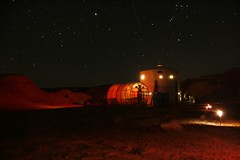Striking Photos From The Mars Colony In Utah's Desert
Some desert areas in Utah look like the
could be from another planet and, indeed, our terrain has stood in
for alien landscape in many moves – from the Planet Vulcan to John
Carter's Mars to the Planet of the Apes.
Some areas have also been used in
scientific research exploring what it might be light to colonize
other planets. An ongoing project has volunteers living in a
simulated Mars colony in the desert outside of Hanksville, near Lake
Powell in southern Utah.
The simulation has made news and been
featured in this blog before and probably will be again. We're
drawing your attention to in now because they have released a bunch
of striking photos showing activity as the crew lives in the “space
colony” and explores the nearby alien terrain.
Many newspapers and magazines are
publishing articles that include the photos. The UK's Daily Mail has
this
article, which includes more photos than any other I perused. The
photos are worth viewing.
Below are excerpts from the article. The comments at the end of the
article are also worth reading.
The project is
called the Mars Desert Research Station (MDRS), a simulated off-world
habitat that serves as a test site for field operations in
preparation for future human missions to Mars.
All outdoor
exploration is done wearing simulated spacesuits and carrying air
supply packs and crews live together in a small communication base
with carefully rationed essentials - everything needed to survive
must be produced, fixed and replaced on-site.
Each crew spends
between two weeks and a month living in a habitat unit, performing
the kind of work astronauts will be expected to carry out on Mars,
such as collecting rock samples from the surface and examining them
back in the habitat, conducting life science experiments and studying
the local geology and geomorphology.
The Utah site is
one of two operated by the Mars Society as part of its Mars Analog
Research Station (MARS) project. The other site is located in the
Canadian Arctic, with two more planned for the Australian outback and
Iceland.
These locations
were chosen because some environmental conditions, geologic features
or biological attributes may be similar to those thought to be
encountered on Mars.
The MDRS website
says: “'Offering profound enlightenment to our science, inspiration
and purpose to our youth, and a potentially unbounded future for our
posterity, the challenge of Mars is one that we must embrace.”










0 Comments:
Post a Comment
<< Home